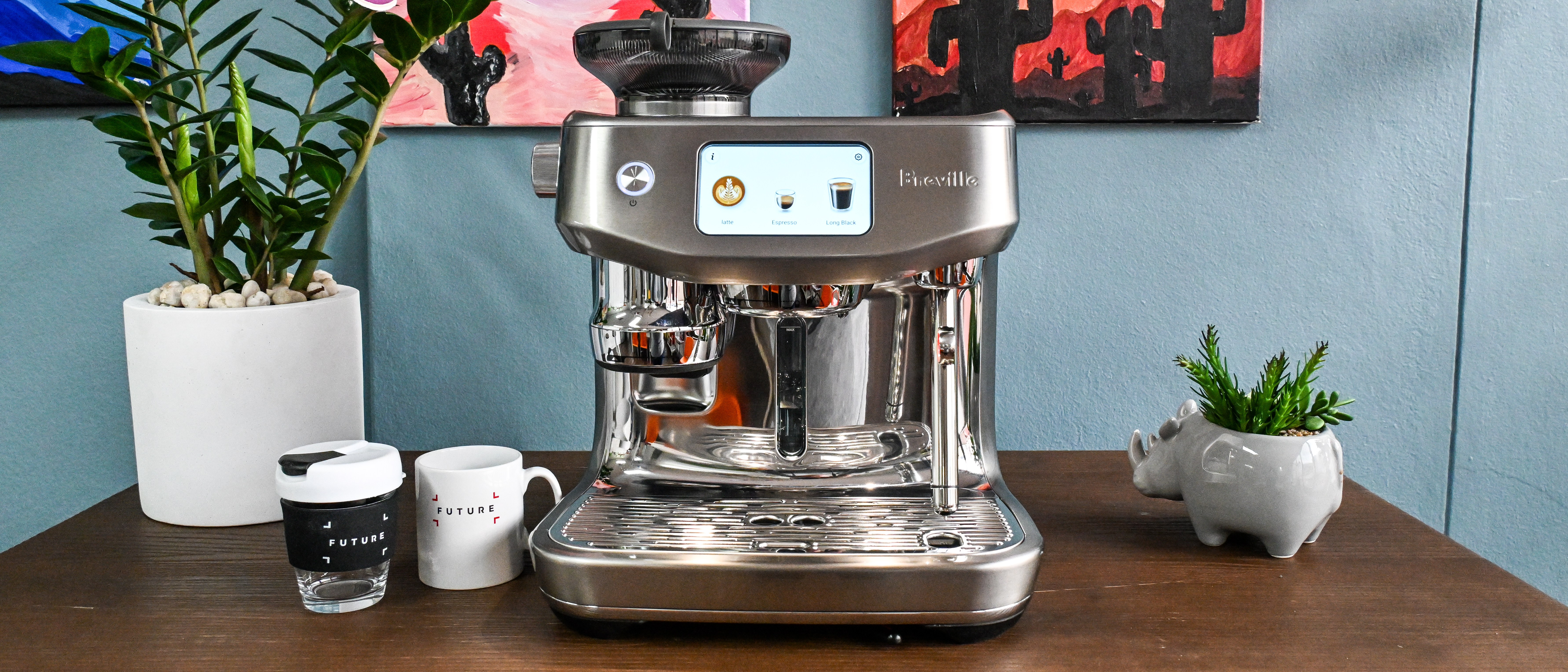TechRadar Verdict
The Breville Oracle Jet is an incredibly advanced yet user-friendly espresso machine that blends automation with barista-level control. It’s perfect for those who want high-quality coffee at home without the learning curve of a fully manual machine. From precision grinding to automatic milk frothing, every step is easy and enjoyable, with the device delivering top-notch espresso with minimal effort. While it’s a hefty investment – and a hefty bit of kit – it’s one of the best options for coffee enthusiasts who want cafe-quality drinks at home at the push of a button.
Pros
- +
Exceptional espresso quality
- +
Automatic grinding, tamping and milk frothing
- +
Large, intuitive touchscreen
- +
Smart grind adjustment guidance
- +
Super easy to use and create quality drinks
Cons
- -
Pricey
- -
Takes up quite a lot of space
- -
Grinder can be messy
- -
Can’t brew and steam simultaneously
Why you can trust TechRadar
Breville Oracle Jet: two-minute review
The Breville Oracle Jet is a serious contender in the world of high-end espresso machines, offering an impressive mix of automation and precision. Designed to cater to both beginners and seasoned coffee enthusiasts, this high-tech machine helps simplify the often-fiddly process of making high-quality espresso, offering consistent results with minimal effort.
The key difference between the Jet and its immediate predecessor – the Oracle Touch – is that this newer model has adopted Breville’s fast-heating ThermoJet boiler technology. This means that the Jet’s ready to extract a coffee shot in around 30 seconds after being powered on, rather than the 3 or more minutes you’ll have to wait with the Oracle Touch and its older-style dual boilers.
One of the Oracle Jet’s standout features is its high-precision burr grinder. With 45 settings, it allows for ultra-fine adjustments to the grind size so that you can get the consistency you need from your coffee beans. This is a really valuable feature, especially since I’ve found many of the best espresso machines require a lot of trial and error to get this right, which wastes time (and coffee). The Oracle Jet really doubles down on this, providing real-time feedback on extraction, and guiding you in getting the perfect shot every time.

While the automatic tamping system serves up a uniform coffee puck time and time again, I found that the grinder could be a little messy, occasionally leaving stray grounds on the portafilter and even on the worktop around the machine, but it’s nothing a quick wipe won’t sort out.
The machine makes up for this minor inconvenience with its sizeable, intuitive touchscreen, which makes the entire brewing process not only feel super premium, but truly effortless. It walks you through drink selection, grinding, extraction and milk frothing in a really fluid and enjoyable way, making it almost impossible to get a bad coffee. And the Auto MilQ steam wand automatically textures milk to the right consistency for your drink of choice, even adjusting settings based on whether you're using dairy or plant-based alternatives – a rare but certainly welcome feature in the world of home espresso makers.
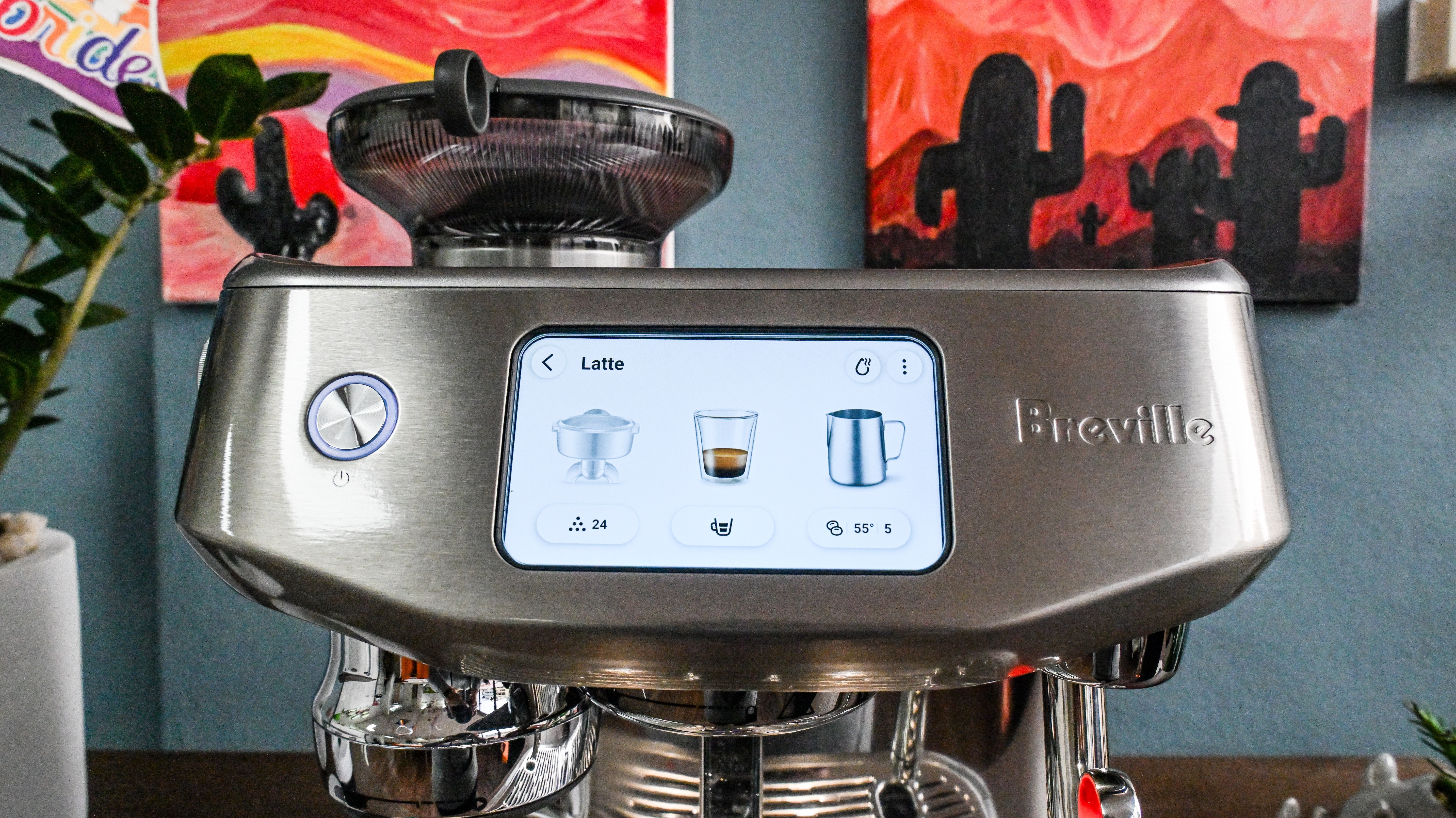
Despite its many conveniences, Breville’s impressive machine does have some drawbacks. It’s quite bulky and heavy, so you’ll need ample kitchen worktop space. And the lack of simultaneous brewing and milk steaming means that if you’re making multiple drinks, the Oracle Jet can be a little slower than its dual-boiler predecessors, such as the Oracle Touch. And, of course, the $1,999.95 / AU$3,399 price tag makes it a considerable investment.
Still, for those who want top-tier espresso without the hassle, the Breville Oracle Jet delivers. It offers barista-level quality at the touch of a button, making it what I believe to be one of the most advanced and user-friendly coffee machines on the market today.
Sign up for breaking news, reviews, opinion, top tech deals, and more.
Breville Oracle Jet: price and availability
- Available to buy now, priced at $1,999.95 / AU$3,399
- Sold under the Sage brand in the UK
- More expensive than most competitors
Arriving in Breville’s home territory of Australia first – where it's currently priced at $3,399 – the Oracle Jet launched in July 2024, and then made its way to the US a few months later, where it carries an MSRP of $1,999.95. Available from the brand's official web store as well as many major retailers, it comes in Truffle Black, Stainless Steel and Sea Salt White in Australia, while buyers in the US get additional Damson Blue and Olive Tapenade (aka green) options.
Compared to Breville’s other high-end models, the Oracle Jet sits between the Barista Touch Impress ($1,499 / AU$1,999) and the flagship Oracle Touch ($2,799.95 / AU$3,699), making it quite definitively a high-range option.
While there are few other espresso machines on the market that offer the Oracle Jet’s exact mix of features, the Oracle Jet holds its ground well when stacked up against other semi-automatic rivals. There’s the Ninja Luxe Café ($499 / around AU$750), which offers a semi-automatic espresso setup with some smart features at a fraction of the price in select markets (currently unavailable in Australia), but lacks the same precision and customization.
Meanwhile, the De'Longhi La Specialista Touch ($1,000 / AU$1,299) is another alternative featuring a touchscreen and automated milk frothing in a smaller footprint and at a much lower cost, but it doesn’t feature the same level of automation around grinding and tamping, or the cold brew functionality of the Oracle Jet.
- Value score: 4/5
Breville Oracle Jet: specs
Dimensions | 19.2 x 15 x 14.5 inches / 48.8 x 38.1 x 36.8cm |
Weight | 26.9lbs / 12.2kg |
Grinder | 45-setting burr grinder |
Drink options | 11, including espresso, latte, cappuccino, cold brew, and hot chocolate |
Milk frothing | Automatic, with presets for dairy and plant-based milks |
Water tank | 2qt / 2.3l (front-fillable) |
Smart features | Auto grind adjustment, Wi-Fi updates |
Breville The Oracle Jet: design
- High-end build with sleek finish
- Intuitive touchscreen for easy navigation
- Clever built-in features like hidden wheels
The Breville Oracle Jet is a serious piece of kit. Right out of the box, everything about it screams premium, and given the lofty price tag you’d be right to have high expectations, too. With a brushed stainless steel finish on the variant sent to me for this review, it has a sleek, pro feel that will certainly look the part in any kitchen, provided you’ve got the space for it.
That’s the thing – this isn’t some compact coffee maker you can tuck away in the corner of your kitchen. It’s around 20 inches wide and 15 inches deep (or 50cm x 40cm), so you’ll need a fair amount of free worktop space to fit this beast in comfortably. It's also pretty weighty, weighing in at over 26lbs / 12kg, so you might even need someone to help you lift it out of the box.
Once you've got it set up in the desired spot, it’ll be hard not to immediately fall in love with the 5-inch touchscreen, which dominates the front of the machine for good reason – it’s your guide through the entire coffee-making process. Whether you’re brewing a classic espresso shot or frothing milk for a cappuccino, the Oracle Jet provides clear, easy-to-follow instructions through text and images. There's even a preset for espresso martini!
There's light and dark modes for the interface, which is a nice customization touch to suit your kitchen lighting. The interface is smooth and responsive, which is a relief since the screen on Breville’s last machine, the Barista Touch Impress, could be frustratingly sluggish at times. It now works as expected, making swiping between different drink options a dream.
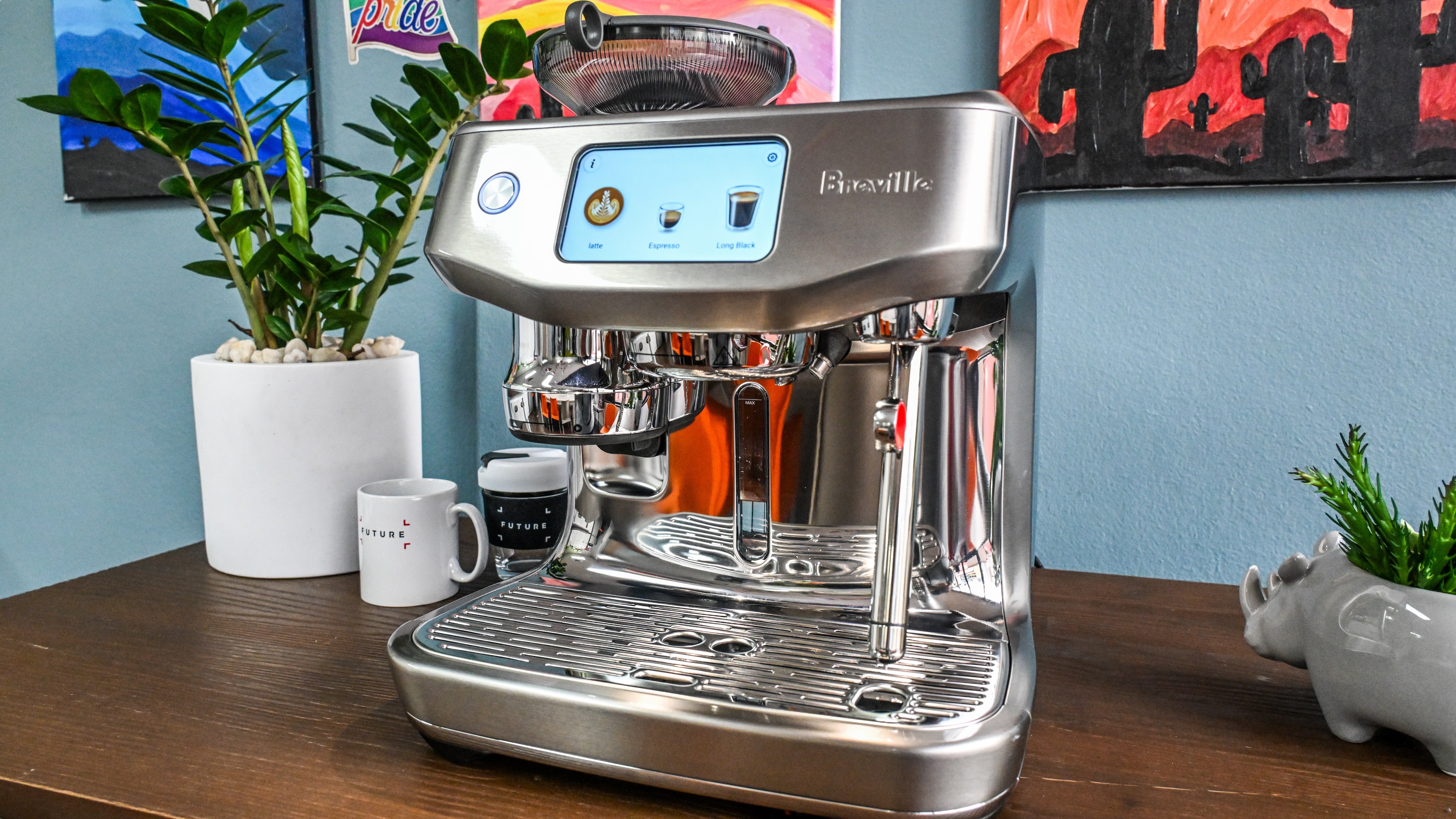
One of the Oracle Jet’s most thoughtful features is the front-fillable 2qt / 2.3L water tank. If you’ve ever had to awkwardly shuffle a big ol’ espresso machine around just to access and refill the water tank, you’ll definitely appreciate this design feature, as it means you just need to lift up a front flap and pour from a jug straight from the tap. There’s also a window just above the drip tray so you can clearly see the water level, but you’ll also receive alerts on the touchscreen when the tank needs refilling.
Another handy feature is the addition of hidden wheels on the machine’s underside. Given its size and weight, you might expect the Oracle Jet to be a hassle to move, but a simple swipe of the lever under the drip tray lifts the machine onto its 360º wheels, making it incredibly easy to slide around and reposition. It’s a small detail, but one that shows Breville has really considered usability for its customers.
The grinder and portafilter system also boast brilliant build quality, with automatic grinding and tamping, which takes much of the guesswork (and the effort) out of making espresso, but I’ll talk more about that in the performance section. The 58mm portafilter is barista-standard for even extraction, but it also feels well built and weighty in the hand, like it should.

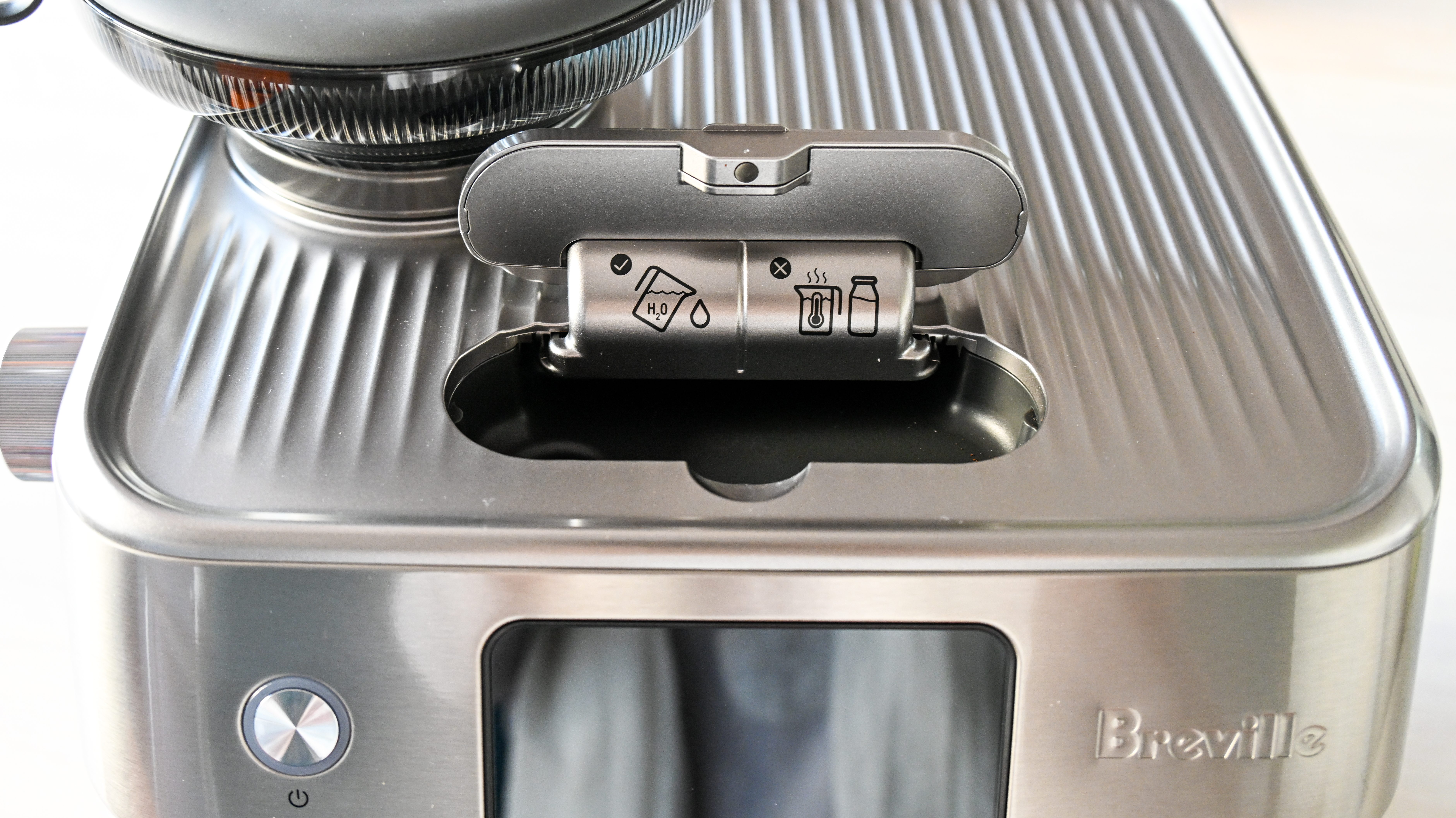
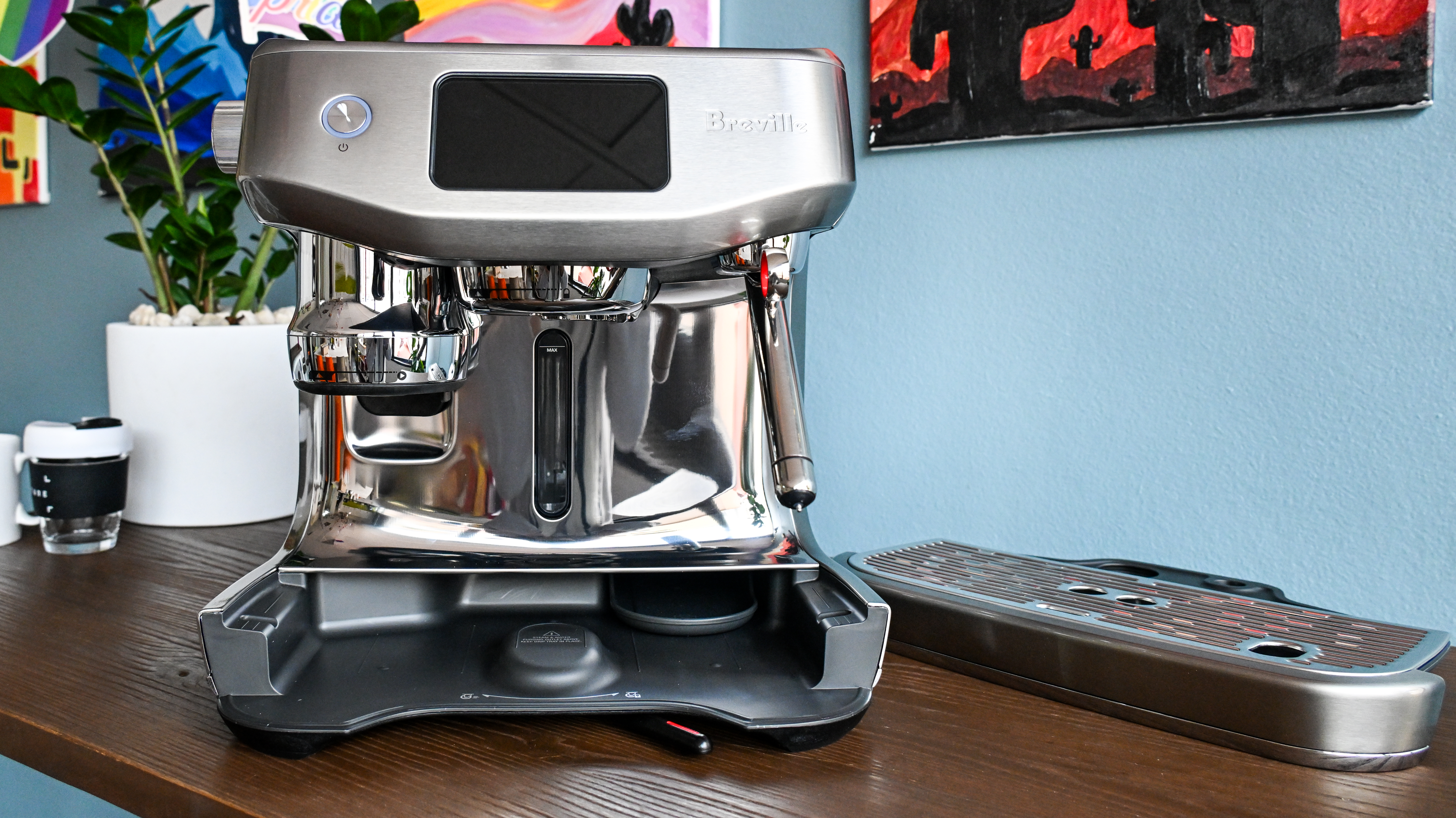
The Auto MilQ steam wand is another standout. It automatically textures milk to the consistency required for whichever type of drink you’re making – and the neat thing here is that you can input the type of milk you’re frothing, whether that’s your standard dairy or plant-based alternatives like soy, oat or almond. Coffee-brewing control freaks will be pleased to hear they still have the option to steam manually, too.
However, the machine’s one main drawback is that unlike previous Oracles, you can’t brew and steam at the same time. If you’re making multiple milk-based coffee drinks, you’ll have to wait for one process to finish before starting the other, which can slow things down compared to its predecessors. This is due to the machine’s single ThermoJet heating system. Unlike dual-boiler machines, which have separate boilers for brewing and steaming, the Oracle Jet uses one heating element for both tasks.
If it’s a dealbreaker for you, Breville’s slightly pricier (but not quite as smart) Oracle and Oracle Touch machines do feature a dual-heating system, so these might be worth considering if you frequently make a large number of coffees.
- Design score: 4.5/5
Breville The Oracle Jet: performance
- Automatic grind and tamping give top results time and time again
- Fast heating and smooth espresso extraction
- Cold brew and iced coffee options
The Breville Oracle Jet is built to take the hassle out of home espresso, and after using it for a few months in TechRadar's Sydney office – incidentally replacing the Breville Oracle Touch, I can confidently say it delivers on that promise. From grinding to milk frothing, almost everything is automated, making it ideal for anyone who wants great coffee without the hassle.
Let’s start with the grinder. It has 45 settings, which means you can seriously fine-tune your grind size to suit whatever beans you're using. The smart thing about this is that the machine even tells you if your shot is under- or over-extracted, so you know whether to adjust the grind next time. This is a game changer if you’ve ever struggled with dialling in a manual espresso machine and haven’t been able to nail the extraction.
The automatic tamping system also works really well here, as it means you don’t have to worry about pressing too hard or too softly – you just let the machine do the work. That said, it does have a habit of leaving a few stray coffee grounds behind, which isn’t a huge deal but means a bit of extra clean-up.
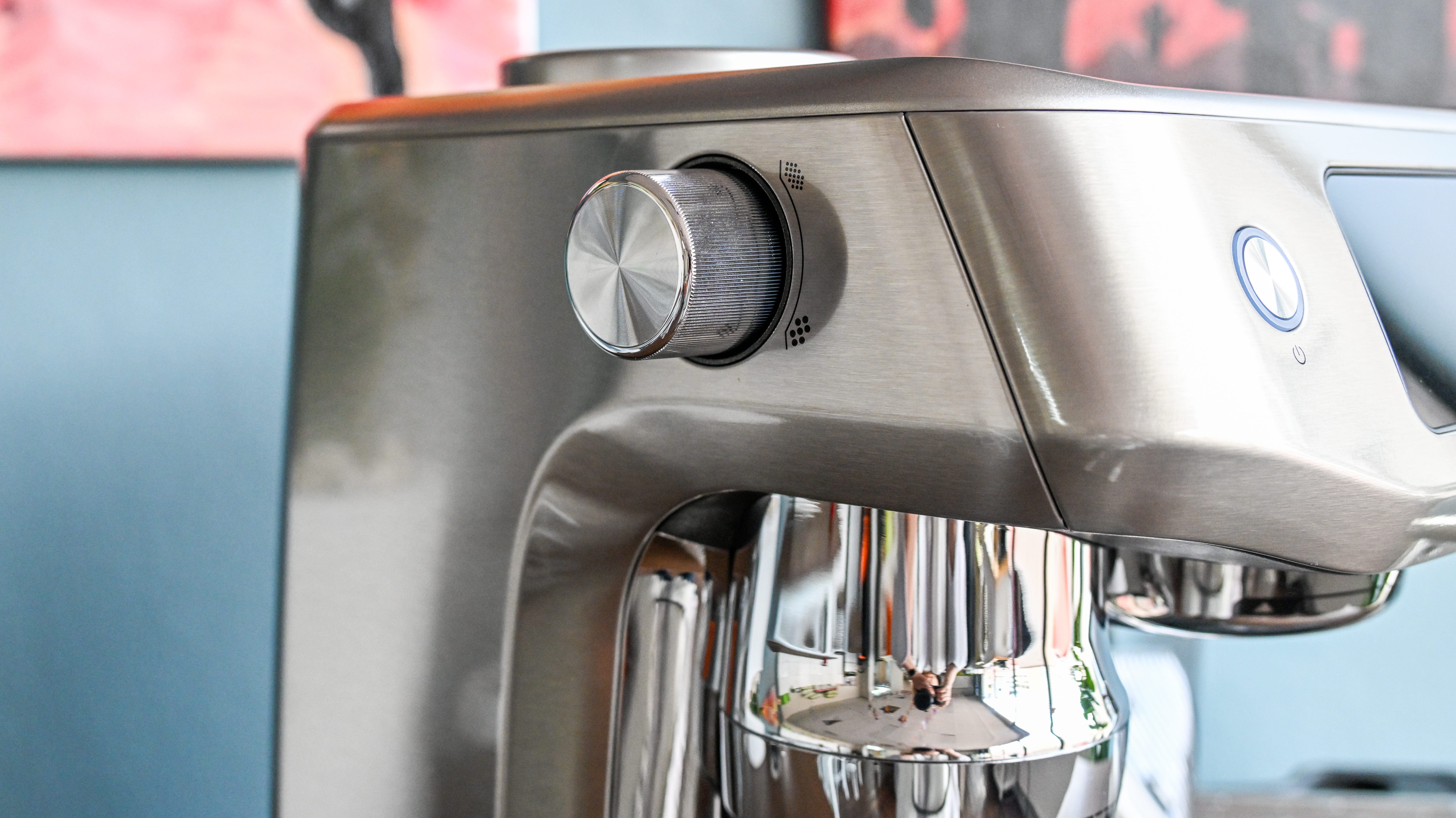

When it comes to pulling a shot, the dual ThermoJet system heats up almost instantly, so there’s no waiting around like with cheaper machines. I found espresso extraction to be smooth and consistent, with rich, balanced flavors – whether you’re using high-end beans or just grabbing something from the supermarket. I used the standard Woolworth's espresso beans easily available in Australia where this machine was tested (costing AU$18 per kilo) and these proved equally satisfying in my morning coffee, offering a lovely full-bodied and smooth taste. I suspect this was down to the machine making the most of how they were brewed.
The real-time shot timer on the touchscreen is also worth a mention. It’s probably one of my favorite features on this machine – turning green if your shot is timed well or red if something’s off, giving you immediate feedback. Impressive!
The Auto MilQ steam wand also adds to the top performance experience of the Oracle Jet. The milk textures it produces are always silky smooth, and ideal for making latte art if you’re into that (not that I could produce anything worth looking at, but that’s down to my lack of skills). While manual milk frothing is an option, most people will probably prefer the automatic setting and it produces great results.

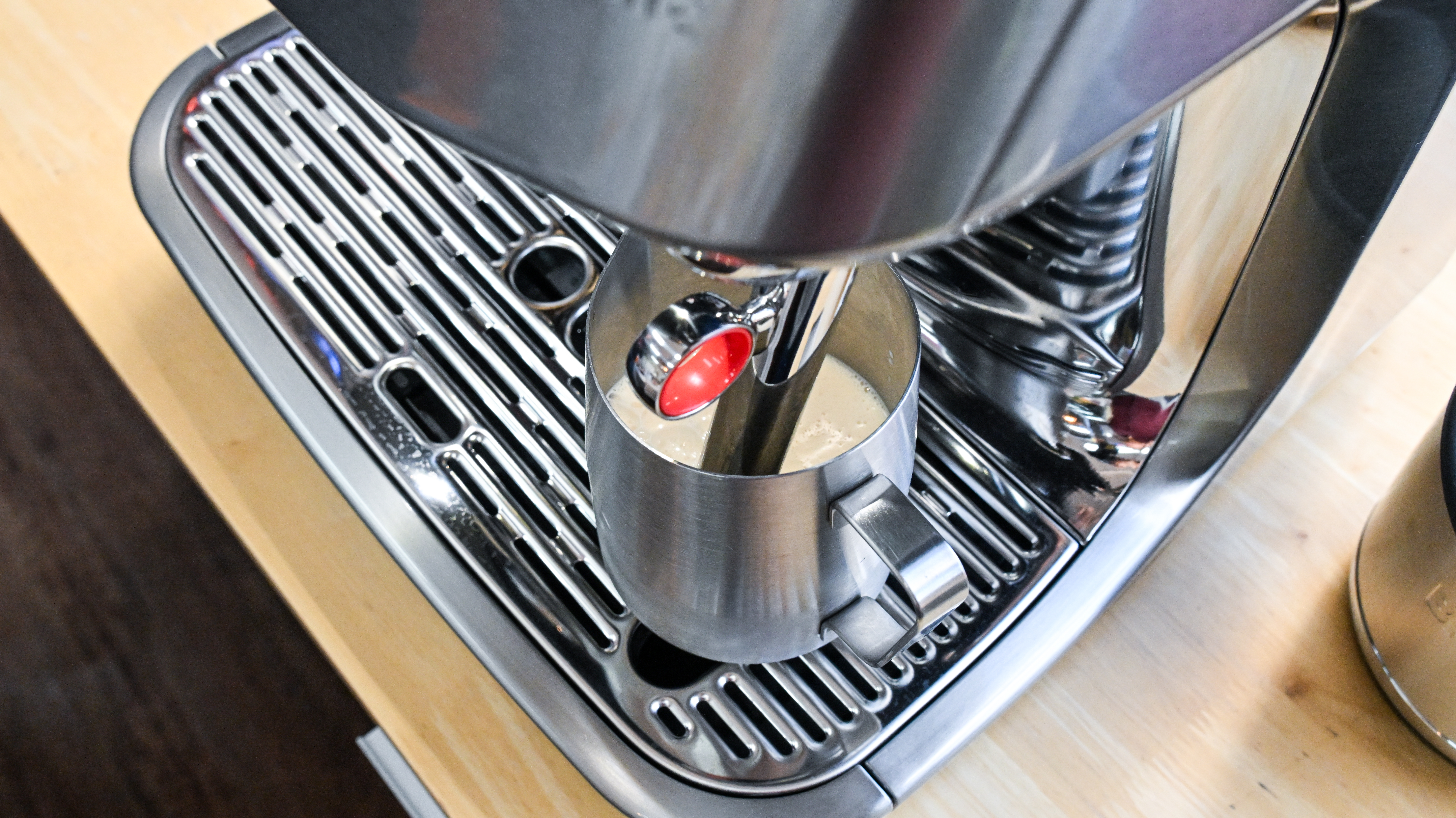
One of the more unique features on the Oracle Jet is its cold brew and cold espresso modes. Cold espresso is perfect for iced lattes, keeping the flavors bold without melting the ice too quickly. The cold-brew function isn’t quite the same as traditional overnight steeping, in that it uses room-temperature water to perform a slow multi-minute extraction, but it still produces a smoother, less acidic coffee in a fraction of the time (and effort) that it takes to make the real thing.
Cleaning is another area where the Oracle Jet makes life easy. Despite the mess the grinder can sometimes make, it has automatic cleaning cycles for the steam wand and internal components, so there’s not much hands-on maintenance. You’ll still need to rinse the portafilter and wipe down and empty the drip tray, but overall, it’s much lower effort than most espresso machines that I've tested.
- Performance score: 4.5/5
Should you buy the Breville Oracle Jet?
Buy it if
You want barista-quality coffee without the effort
The Oracle Jet automates most of the process, ensuring consistent results every time.
You’re happy to pay extra for a top quality appliance
If you’re one for appreciating the finer things in life and don’t mind paying extra for the privilege of a well-built and stylish machine, then you’ll be right at home with the Oracle Jet.
You love cold coffee
The cold brew and cold espresso functions are rare on machines of this type.
You want smart guidance
The real-time extraction feedback and grind adjustment tips help you master espresso-making and makes you feel like a pro with very minimal effort.
Don't buy it if
You’re on a budget
At nearly $2,000 / AU$3,500, the Oracle Jet is certainly not a casual purchase. It’s an investment that will last you years to come, so it's definitely more aimed at those who are serious about creating barista-quality coffee at home.
You need a compact machine
It’s large and it’s pretty heavy, so not ideal for smaller kitchens or those tight on space.
You want to brew and steam at the same time
The single ThermoJet system used for brewing and milk steaming means they can't be used simultaneously, so not ideal for those who want to make a swift cup of coffee before dashing off to work.
Breville Oracle Jet: also consider
Ninja Luxe Café
Price: $499 (around AU$750)
A more affordable bean-to-cup option that still offers some automation, including guided espresso pulls and an automatic frother. However, it lacks the fine-tuned grind settings and high-end build of the Oracle Jet, and it’s not currently available in Australia.
Read our full Ninja Luxe Café review
Breville Barista Touch Impress
Price: $1,499 / AU$2,299
A slightly less expensive alternative from Breville with many of the same automation features, including Auto MilQ milk frothing and guided espresso adjustments. However, it lacks the cold brew and cold espresso options and the digital display just isn’t quite as swift as that on the Oracle Jet.
Read our full Breville Barista Touch Impress review
De’Longhi Eletta Explore
Price: $1,899.99 / AU$1,799
An accomplished bean-to-cup coffee machine that’s perfect for coffee lovers who don’t have the time to maintain an espresso machine. Plus, it can make both hot and cold beverages and comes with everything you might need for a fully operational caffeination station.
Read our full De’Longhi Eletta Explore review
How I tested the Breville Oracle Jet
I used the Breville Oracle Jet for just over a month at home, making two coffee drinks per day using a mixture of high quality Lavazza decaf and fully caffeinated coffee beans. During testing, I noted flavors, consistency, temperature, time to brew, and noise levels. Beyond drinking the espresso and coffee black, I tried the different milk frother presets with both dairy and plant-based milk, observing the foam levels and differences between settings. In the end, I tested almost every setting on the machine and observed how it performed during every step.
Read more about how we test
[First reviewed: August 2025]
Lee Bell is a freelance journalist & writer specializing in consumer technology, health, and lifestyle. Lee is a qualified personal trainer, testing fitness watches, training shoes and everything in between.
- Dan GardinerHead of Content – APAC
You must confirm your public display name before commenting
Please logout and then login again, you will then be prompted to enter your display name.
